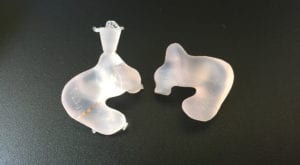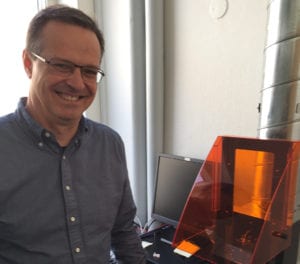
Danish Hospitals Invest in the Best 3D printing Solutions for Audiology.
Rigshospitalet, Department of Otorhinolaryngology, Head and Neck Surgery & Audiology, is based in Copenhagen, the capital region of Denmark. The department consists of two dedicated audiology labs within the Bispebjerg and Gentofte Hospitals. These work closely together in the development of cutting edge hearing solutions for patients.
Why look at 3D printing?
As hospitals specialising in audiology research and hearing device development, the teams at Bispebjerg and Gentofte Hospitals had seen the development of hearing technology from early bulky hearing aids through to modern, almost invisible in-ear devices.
The potential to make smaller, less intrusive and higher performing devices was always the aim of the team, and a huge part of that was the development of better fitting devices. 3D printing and ear scanning technology is the latest development, allowing audiologists to create devices exclusively for that patient and their individual needs.
Many businesses including the biggest names in the industry are already seeing the benefits that 3D printing is bringing to their patients, so it was the next logical step for the hospitals.
“3D printing brings the ability to produce custom hearing aids that not only fit and perform better, but also take a fraction of the time to manufacture” - Erik Kjærbøl, M. Sc. E.E. Rigshospitalet
Why EnvisionTEC?
The hospital teams looked at a number of manufacturers and engaged with r.a.p.s, a local distributor to look at their different options. They required two machines for the two sites. A pre-requisite was that they should to be compatible with 3Shape scanners and software, plus CAMbridge.
The r.a.p.s team demonstrated a number of EnvisionTEC solutions including a range of audiology focused desktop and large frame 3D printers. They also showed the team the range of audiology focused materials available.
The hospital team were particularly impressed with the materials range and the speed and quality of the printed hearing aid shells. After discussion it was decided to invest in two DDSP machines, one for each hospital.
Results
The team now produces, or receives wax impressions of the patients ear. These are converted to digital files using the in house 3Shape scanner and manipulated in 3Shape EarMouldDesigner. Finally these files are tweaked in CAMbridge and sent to the printer. The resulting printed hearing appliances are then post processed and finally adjusted to the patient.
“The speed and accuracy of the EnvisionTEC machines allows us to provide a much better product to our patients in a fraction of the time it would have taken with traditional methods. ” - Erik Kjærbøl, M. Sc. E.E. Rigshospitalet
Using the printer the team produce both end use shells in EnvisionTEC’s E-Shell 300 and cocoon molds with the E-Silicone material. This allows for the production of soft silicon ear pieces. The team annually produces 4000 hard molds and about 1250 soft molds.
The switch to 3D printing has resulted in a much faster turn around for patients, with devices available within a few days as opposed to weeks. The use of the highly accurate EnvisionTEC printer has also resulted in better fitting appliances that are more comfortable for the wearer.
An additional benefit is the ability to build hearing devices in a range of colors. This allows appliances to be built to the exact requirements of the patient, and even be made more fun and appealing to children.









